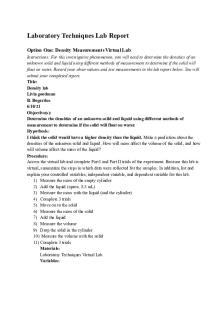Common Laboratory Operations and Techniques PDF

| Title | Common Laboratory Operations and Techniques |
|---|---|
| Course | Medical Technology |
| Institution | Silliman University |
| Pages | 6 |
| File Size | 323 KB |
| File Type | |
| Total Downloads | 4 |
| Total Views | 171 |
Summary
Download Common Laboratory Operations and Techniques PDF
Description
ACTIVITY NO.3
COMMON LABORATORY OPERATIONS/LABORATORY TECHNIQUES I.
INTRODUCTION
The Chemist studies pure substances and mixtures. In order to be sure that he does not introduce impurities through carelessness, or endangers himself or those who work with him, certain procedures had been developed. We call these procedures common laboratory operations or laboratory techniques. These common laboratory operations or laboratory techniques are systematic procedures by which a complex work or scientific piece of work is accomplished. II.
III.
OBJECTIVES A. To be able to name and identify a number of common laboratory operations or laboratory techniques. B. To observe how the different common laboratory operations or laboratory techniques are done. PROCEDURES A. Refer to and familiarize yourself with the drawings illustrating the operations or techniques in numbers 1 – 12. Numbers 8 to 12 are different techniques used in separating components of a mixture. B. 1. Handling of Liquid Solutions: Always bear in mind that chemicals are expensive and must be kept free from contamination. Practice the following steps to handle liquid chemicals safely. Reagent bottles come in various sizes with various kinds of covers or stoppers. Never lay down the stoppers of reagent bottles on the table. a) For reagent bottles that have corks or screw caps for stoppers, remove and keep the cover in your hand. b) For stoppers that have handlers, clip the stopper at the handler with the index and middle fingers as shown below.
c) Note the position of the stopper. Pour slowly. To avoid splashing, use glass rod to guide the liquid as it flows out.
d) Always put back the stopper to the bottle after using. If the reagent spills down the side of the bottle, rinse the side with tap water taking care not to allow the water to enter into the bottle.
2. Handling of Solids: Never handle solids with wet hands. A clean and dry spatula or spoon can be used to remove solids from the reagent bottle as illustrated.
3. Mixing Liquid Solutions Note: When mixing acid and water to prepare dilute solution, REMEMBER, IT IS ACID TO WATER, NOT WATER TO ACID. Solutions are mixed: a) In a test tube. Solutions are mixed with a flicking action of the finger.
b) In an Erlenmeyer flask. Solutions are mixed with a gentle swirl and rotation of the flask.
c) In a beaker. A stirring rod is used to mix the solution.
4. Mixing Solids Before mixing solids, solid must be in a finely divided state. This is done using a mortar and pestle. Because of the heat of friction resulting from the grinding, some substances or materials react. Consult the instructor as to the reactivity of solids before mixing. Solids are mixed in: a) a mortar and pestle, using a firm grinding motion, not pounding motion.
b) a tightly covered vial or bottle, shaken for at least 5 minutes.
5. Heating Liquids Liquids are heated in a: a) test tube Hold the test tube with a test tube holder and incline the test tube about 30o from the horizontal, then apply a small flame below the liquid surface, and agitate the test tube from side to side. Do not point the test tube to the direction of anyone.
b) beaker
to
Place a stirring rod in the beaker or use broken porcelain pieces or glass beads to reduce bumping of the liquid. A wiregauze is placed over the iron ring to support the beaker and even out the heat applied to the beaker.
c)
flask Swirl the flask with the solution over a small flame. Flask can be held with a universal clamp or with a strip of paper folded several times as in the drawing. A setup similar to that of the beaker (in letter b) can be used.
6. Decantation When an insoluble solid is dense or heavy, it settles easily to the bottom of the container. The clear liquid or supernatant liquid that separates is carefully poured out without disturbing the solid. The technique is called decantation. If the solid is fine or does not easily settle down the process of filtration is preferred....
Similar Free PDFs

Laboratory Techniques Lab Report
- 4 Pages

Basic Laboratory Techniques
- 11 Pages

Lab 1 - Laboratory Techniques
- 14 Pages

Common laboratory equipment
- 5 Pages

Common operations in Audacity
- 2 Pages
Popular Institutions
- Tinajero National High School - Annex
- Politeknik Caltex Riau
- Yokohama City University
- SGT University
- University of Al-Qadisiyah
- Divine Word College of Vigan
- Techniek College Rotterdam
- Universidade de Santiago
- Universiti Teknologi MARA Cawangan Johor Kampus Pasir Gudang
- Poltekkes Kemenkes Yogyakarta
- Baguio City National High School
- Colegio san marcos
- preparatoria uno
- Centro de Bachillerato Tecnológico Industrial y de Servicios No. 107
- Dalian Maritime University
- Quang Trung Secondary School
- Colegio Tecnológico en Informática
- Corporación Regional de Educación Superior
- Grupo CEDVA
- Dar Al Uloom University
- Centro de Estudios Preuniversitarios de la Universidad Nacional de Ingeniería
- 上智大学
- Aakash International School, Nuna Majara
- San Felipe Neri Catholic School
- Kang Chiao International School - New Taipei City
- Misamis Occidental National High School
- Institución Educativa Escuela Normal Juan Ladrilleros
- Kolehiyo ng Pantukan
- Batanes State College
- Instituto Continental
- Sekolah Menengah Kejuruan Kesehatan Kaltara (Tarakan)
- Colegio de La Inmaculada Concepcion - Cebu










